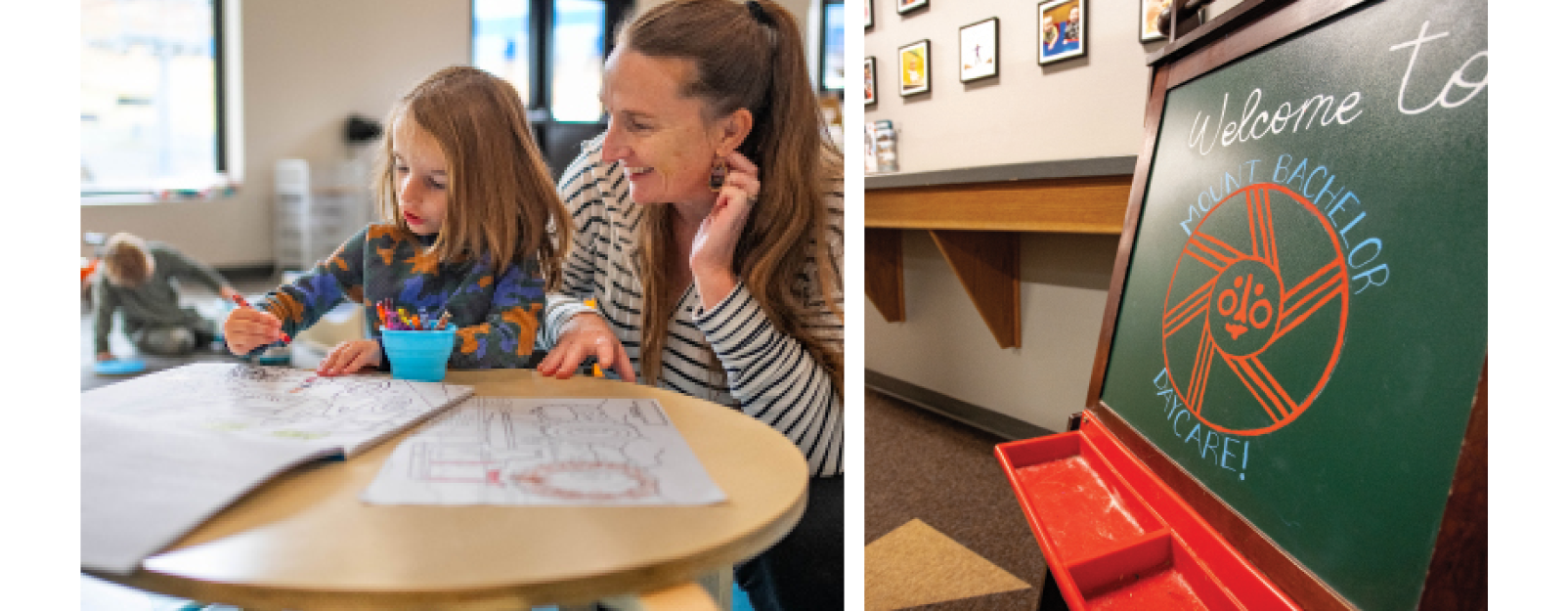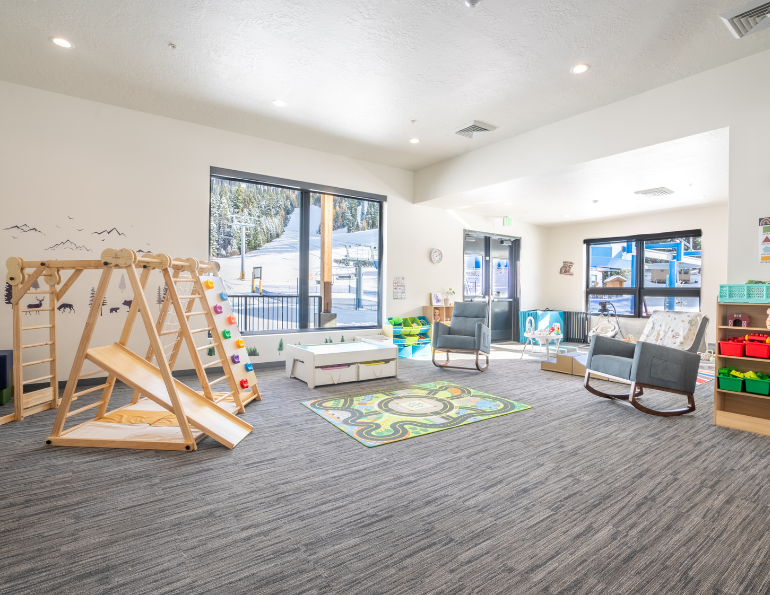Child care at ski resorts has always been a hit-or-miss guest amenity. While many ski areas have invested in employee child care (see “Child Care: A Critical Benefit,” May 2023), the guest experience is far less predictable.
Post-Covid, child care was among the last amenities to come back online, with some centers permanently closed or reopened for employees only, including those at high-profile destination resorts such as Whistler Blackcomb, British Columbia; Jackson Hole Mountain Resort, Wyo.; and Vail Mountain, Colo.
Even when available, child care details are often buried on resort websites, separate from other key services—and bookings frequently rely on outdated methods, including phone calls and emails, instead of simple online transactions.
Challenges in providing child care mirror broader industry issues such as staffing shortages, which have been amplified as regulations around caregiver-to-child ratios and educational standards have become stricter. Rising operational costs and limited space further complicate the equation.
Forced to improvise. What’s the alternative? “The parents take turns skiing,” says Ilsa Wilson, owner of the child care centers at Alta and Snowbird in Utah. But this has its shortcomings. “Now they’ve paid for a full-day ski pass,” which they can’t fully use, Wilson says.
Skiing and riding parents will go to great lengths to find child care, she adds. “I have parents driving from Park City, Snowbasin, Solitude (at least 30 minutes away). They bring their kiddo here, drive back down the canyon, and go ski at the other mountains.” Even more have made the trek since Brighton and Solitude closed their respective child care centers, she says.
Closures and Challenges
The reasons behind closures vary. Whistler Blackcomb closed its center “due to a lack of ECE-qualified providers.” Jackson Hole refocused its Kids Ranch & Daycare on employees. To serve guests, it added “One-on-One Nannies” for children aged 5 months to 3 years, a pre-booked service costing $399 per day.
Community backlash. Closures and resulting frustration aren’t limited to luxury resorts. Bridger Bowl, a nonprofit ski area in Bozeman, Mont., faced public backlash after shutting down its “play care” program ahead of the 2023-24 winter season. A Change.org petition opposing the decision garnered 765 signatures.
Bridger Bowl general manager Hiram Towle cited the need for additional office and retail space and declining usage—post-Covid, the program averaged just seven kids per day. He assured the community, though, that child care is a priority in the resort’s new master plan.
Washington’s Mission Ridge Ski Area also discontinued child care heading into 2024-25. Former general manager Josh Jorgensen called it a financial decision. “It just never got back to break even after Covid,” he says. The space has been repurposed into a staff locker room.
Idaho Resorts Invest
Some resorts are expanding services. Child care at Idaho ski areas, in particular, is seeing a boom.
Brundage Mountain recently opened its 18,000-square-foot MTN Adventure Center, which includes a state-certified day care for children 6 weeks to 6 years old. The new facility serves both employees and guests.
Brundage spokesperson April Whitney says the resort provides child care as a free benefit to employees and is equally committed to ensuring guests can rely on the service.
Day care, says Whitney, is viewed like a free shuttle service: “It supports our overall operations and allows more people to participate in mountain activities.
“We consider day care an extension of our Mountain Sports School, introducing kids at a very young age to the mountain lifestyle,” she adds.
Schweitzer Mountain operates a 2,500-square-foot KinderKamp child-care center for children 4 months to 6 years, located in the resort’s main lodge. The center accommodates up to 65 kids and regularly sells out on weekends and holidays. Skiing guests make up the majority of clients, with about 15-20 percent employee kids.
KinderKamp manager Lacie Brundin-Jordan, who has been with Schweitzer for 22 years, says staffing is based on state ratio requirements. While the center can accommodate up to 50 kids ages 3 to 6, infants require a lower staff-to-child ratio, so availability is more limited. In winter, to meet demand, the center has about 20 staff.
Schweitzer started offering year-round child care a few years ago, says Brundin-Jordan, “when we were struggling to get employees on the mountain.” In the off season, KinderKamp staff is scaled back to about five employees, who care mainly for employee kids—although the program is open to guests, too.
The center turns a profit, but “not to the level of other departments,” she says. “Schweitzer looks at this as a service to get families up here together.” To that end, the resort offers more than just ski- or work-day care. It also offers evening care from 6-8 p.m. on weekends and select holidays for $15 per child (4 months to 11 years). This “Kids Night Out” program is driven primarily by word of mouth, says Brundin-Jordan, often drawing groups of parents who want to enjoy a dinner out.
Schweitzer’s monthly child-care and lesson packages sell out quickly, with options for part-time care (three days a week) at $825/month or full-time (five days a week) at $1,155/month.
Tamarack Resort recently launched a new Basecamp child-care center for guests and remodeled its employee child-care facility with help from a $130,000 state grant. In respect to the separate facilities, chief financial and operating officer Kara Finley notes that employee children have different needs, including “consistent friends and an educational curriculum.”
The new public Basecamp facility serves children up to age 12 and offers year-round outdoor activity programs geared toward guests and homeowners (Tamarack has about 500 base-area homes). Child care alone operates near break-even, but combined with camp revenue, it turns a profit, says Finley.
To enhance family participation, Tamarack offers lodging packages that incorporate child care and a $949 family ski pass, an offering that grew 55 percent year over year.
 Left to right: Brundage considers child care a key service; Mt. Bachelor’s day care welcomes kids year-round.
Left to right: Brundage considers child care a key service; Mt. Bachelor’s day care welcomes kids year-round.
More Expanded Services
Oregon resorts have also expanded child care. Mt. Hood Meadows and Mt. Bachelor both now offer year-round services for children as young as 6 weeks.
In June 2022, Mt. Hood Meadows began providing year-round child care and welcoming back the general public after a yearlong Covid closure and a partial seasonal reopening for employees-only at its 3,544-square-foot on-site day care. Day care director Lauren Yaeger says profitability varies by season, but “Meadows is dedicated to offering affordable child care to employees year-round.”
In winter, guests make up 85 percent of clientele, with spaces for preschool-aged children (2-5 years old) in highest demand. Infant and toddler slots fill up daily due to lower mandated caregiver-to-child ratios. When sold out, Yaeger starts waitlists and offers half-day and hourly rates to accommodate more families. In the summer months, when the resort offers multi-day camps, the demand for spaces for school-aged children is higher.
Independently-Run Day Cares
Some resorts have outsourced child care operations, leaving staffing, care, and regulatory compliance to third parties.
In Utah, the Alta Children’s Center and Superior Child Care at Snowbird provide in-demand services at the top of Little Cottonwood Canyon. Wilson, who owns both, assumed ownership of the Alta Center seven years ago; her success there led to a proposal from Snowbird to take over its child care center. She leases the spaces from the respective ski areas.
Wilson notes staffing as a major challenge. Demand varies daily, so she maintains “an extensive substitute teacher list” to supplement permanent staff. To manage availability, she closes online reservations 48 hours out to adjust staffing levels before accepting additional kids.
Big Sky Resort, Mont., is another example. It offers day care for kids 6 months to 8 years through Lone Peak Playhouse, an independently operated on-resort facility. Owner Jessica Thorn estimates 95 percent of bookings come from resort guests. (The Big Sky Community Trust program offers local subsidized child care for employees.)
The highest demand is for 2- to 3-year-olds—“Kids who are old enough to travel but not yet skiing,” says Thorn. And the center often sells out.
Lone Peak coordinates with the mountain sports school to combine day care with lessons. It also operates a second location at the Madison Base, primarily on holidays and weekends. While mainly a winter operation, it occasionally opens in summer for conferences and large groups.
Ticketing and Pass Options Fill the Gap
A few ski areas that do not offer day care have introduced family-friendly ticketing options to help parents share child care duties.
Pricing for parents. Oregon’s Anthony Lakes Mountain Resort offers the Save Our Sanity (SOS) Ticket, providing couples with non-skiing kids aged 3 and under two day tickets for $70, with the stipulation that only one parent can ski at a time.
Timberline Lodge, Ore., launched its Parenthood Pass in 2013, allowing parents of kids 10 and under to share a pass between them. Director of marketing and PR John Burton says the pass only represents a small segment of total sales, but adds, “its popularity continues to grow.
“More importantly, it’s helping to cultivate a love of skiing and snowboarding in new families, ensuring a vibrant future.”
What Moms (and Dads) Want
For parents, especially moms, the lack of reliable, affordable child care can make or break a trip to the slopes. Beyond the family ski day, child care also impacts conferences, events, and competitions, where organizers, participants, and competitors can benefit from reliable options.
The stakes are high. The 2023-24 NSAA Kottke End of Season and Demographic survey revealed that the ski industry remains predominantly male, with men comprising 62 percent of participants. In a push to encourage the ski industry to better support women and families, Nicole Feliciano, founder of the popular MomTrends blog, conducted a groundbreaking Ski Moms’ Happiness Survey, polling 1,000 women with children under age 6 in 2023-24.
Just 34 percent of Happiness Survey respondents agreed that the ski industry cares about supporting families and making skiing accessible, while an overwhelming 87 percent said they would ski or snowboard more often if on-mountain child care were available.
The call to action is clear: If resorts want to attract families and ensure a future pipeline of skiers and riders, quality and convenient child care should be a high priority.






